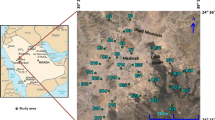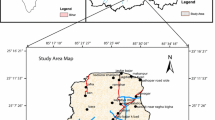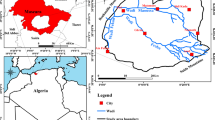Abstract
A comprehensive groundwater quality investigation of 98 representative groundwater samples collected from Chincholi MIDC area has been carried out to identify the impact of different land uses on groundwater quality during pre- and post-monsoon seasons of 2014. Hydrochemical results confirm that groundwater is slightly alkaline and hard to very hard type. The contents of TDS, Na, Ca, NO3 and K exceeded the permissible limit prescribed by BIS in industrial land use in both the seasons. The ionic ratios suggest that silicate weathering is dominant hydro-geochemical process followed by carbonate weathering and ion exchange. The correlation and principal component analysis identifies the relation among different parameters and mixed sources of ionic constituents. The cluster analysis differentiates the samples affected due to anthropogenic activities through the classification of groundwater samples in different clusters, and principal component analysis identifies the EC, Ca, Mg, Cl, NO3, TH and TDS as major causative factors. The spatiotemporal maps depict the enrichment of specific ions mainly observed at industrial and agricultural sites. Samples located in industrial area vicinity are not suitable for drinking and irrigation. From an industrial perspective, groundwater is corrosive and incrusting in nature. Groundwater sample numbers 14 and 15 located in agricultural area and 29, 30, 41, 42, 43 and 47 in the vicinity of industrial area found problematic represent that the change in water quality is caused due to alteration in land use type. Therefore, it becomes immensely important to identify the negatively impacted groundwater quality and mitigate the cause.











Similar content being viewed by others
References
Agarwal, V. C. (2012). Groundwater hydrology (p. 259). New Delhi: PHI Learning Pvt.
American Public Health Association (APHA). (2005). Standard methods for the examination of work and wastewater (21st ed.). New York: American Public Health Association.
Anonymous. (1983). Groundwater and Wells. Johnson division (1st ed., p. 450). Visakhapatnam: Jain Brothers.
Bhakar, P., & Singh, A. P. (2018). Groundwater quality assessment in a hyper-arid region of Rajasthan, India. Natural Resources Research,11, 1–18.
BIS. (2000). Drinking water specification (p. 10500). New Delhi: Bureau of Indian standards.
Canter, L. W. (1997). Nitrates in groundwater. Boca Raton: CRC Press.
Cerling, T. E., Pederson, B. L., & Von Damm, K. L. (1989). Sodium-calcium ion exchange in the weathering of shales: Implications for global weathering budgets. Geology,17(6), 552–554.
Chanakya, V., & Jeevan, R. K. (2010). Impact of industrial effluents on groundwater quality. Journal of Environmental Science and Engineering,52(1), 41–46.
Chitsazan, M., Aghazadeh, N., Mirzaee, Y., & Golestan, Y. (2017). Hydrochemical characteristics and the impact of anthropogenic activity on groundwater quality in suburban area of Urmia city, Iran. Environment, Development and Sustainability. https://doi.org/10.1007/s10668-017-0039-1.
Clarke, F. E., & Barnes, I. (1964). Preliminary evaluation of corrosion and encrustation mechanisms in tube wells of the Indus Plains (p. 81). West Pakistan: US Geol. Survey open-file report.
Clarke, F. E., & Barnes, I. (1969). Evaluation and control of corrosion and encrustation in tube wells of the Indus Plains, West Pakistan. Geol. Surv. Water-Supply Pap., United States, 1608.
CPCB. (2005). Central pollution control board, India performance status of common effluent treatment plants in India.
Das, P. P., Sahoo, H. K., & Mohapatra, P. P. (2016). An integrative geospatial and hydrogeochemical analysis for the assessment of groundwater quality in Mahakalapara Block, Odisha, India. Environmental Earth Sciences,75(2), 1–18.
Datta, P. S., & Tyagi, S. K. (1996). Major ion chemistry of groundwater in Delhi area: Chemical weathering processes and groundwater flow regime. Journal-Geological Society of India,47, 179–188.
Fedrigoni, L., Krimissa, M., Zouari, K., Maliki, A., & Zuppi, G. M. (2001). Origin of the mineralization and hydrogeochemical behavior of a water table subjected to severe natural and anthropic constraints: Example of the Djebeniana aquifer (Tunisia). Proceedings of the Academy of Sciences—Series IIA-Earth and Planetary Science,332(11), 665–671.
Fisher, R. S., & Mullican, W. F., III. (1997). Hydrochemical evolution of sodium-sulfate and sodium-chloride groundwater beneath the northern Chihuahuan Desert, Trans-Pecos, Texas, USA. Hydrogeology Journal,5(2), 4–16.
Foster, S. (1998). Groundwater: Assessing vulnerability and promoting protection of a threatened resource. In Stockholm water symposium (pp. 79–90).
Geological Survey of India (GSI). (2001). District resource map. Solapur District: GSI.
Giridharan, L., Venugopal, T., & Jayaprakash, M. (2008). Evaluation of the seasonal variation on the geochemical parameters and quality assessment of the groundwater in the proximity of River Cooum, Chennai, India. Environmental Monitoring and Assessment,143(1–3), 161–178.
Govil, P. K., Sorlie, J. E., Murthy, N. N., Sujatha, D., Reddy, G. L. N., Lund, R. K., et al. (2008). Soil contamination of heavy metals in the Katedan Industrial Development Area, Hyderabad, India. Environmental Monitoring and Assessment,140, 313–323.
Hauser, B. (2001). Drinking water chemistry: A laboratory manual. Boca Raton: CRC Press.
Hem, J. D. (1985). Study and interpretation of the chemical characteristics of natural water (Vol. 2254). Department of the Interior, US Geological Survey.
Hounslow, A. (1995). Water quality data: Analysis and interpretation. Boca Raton: CRC Press.
Islam, A. R. M. T., Ahmed, N., Bodrud-Doza, M., & Chu, R. (2017a). Characterizing groundwater quality ranks for drinking purposes in Sylhet district, Bangladesh, using entropy method, spatial autocorrelation index, and geostatistics. Environmental Science and Pollution Research,24(34), 26350–26374.
Islam, A. T., Shen, S., Haque, M. A., Bodrud-Doza, M., Maw, K. W., & Habib, M. A. (2017b). Assessing groundwater quality and its sustainability in Joypurhat district of Bangladesh using GIS and multivariate statistical approaches. Environment, Development and Sustainability,19, 1–25.
Jaiswal, R. K., Mukherjee, S., Krishnamurthy, J., & Saxena, R. (2003). Role of remote sensing and GIS techniques for generation of groundwater prospect zones towards rural development—An approach. International Journal of Remote Sensing,24(5), 993–1008.
Jankowski, J., & Acworth, R. I. (1997). Impact of debris-flow deposits on hydrogeochemical processes and the development of dryland salinity in the Yass River Catchment, New South Wales, Australia. Hydrogeology Journal,5(4), 71–88.
Jeong, C. H. (2001). Effect of land use and urbanization on hydrochemistry and contamination of groundwater from Taejon area, Korea. Journal of Hydrology,253(1), 194–210.
Kale, S. S., Kadam, A. K., Kumar, S., & Pawar, N. J. (2010). Evaluating pollution potential of leachate from landfill site, from the Pune metropolitan city and its impact on shallow basaltic aquifers. Environmental Monitoring and Assessment, 162(1–4), 327–346.
Karanth, K. R. (1987). Ground water assessment: Development and management (p. 725). New Delhi: McGraw-Hill.
Kelley, W. P. (1951). Alkali soils; their formation, properties, and reclamation (No. 04; RMD, S595 K4.).
Kirda, C. (1997). Assessment of irrigation water quality. Options Mediterraneennes. Serie A: Seminaires Mediterraneens (CIHEAM).
Kortatsi, B. K. (2007). Hydrochemical framework of groundwater in the Ankobra Basin, Ghana. Aquatic Geochemistry,13(1), 41–74.
Kumar, P. S., & James, E. J. (2017). Geostatistical and geochemical model-assisted hydrogeochemical pattern recognition along the groundwater flow paths in Coimbatore district, South India. Environment, Development and Sustainability. https://doi.org/10.1007/s10668-017-0043-5.
Kumari, S., Singh, A. K., Verma, A. K., & Yaduvanshi, N. P. S. (2014). Assessment and spatial distribution of groundwater quality in industrial areas of Ghaziabad, India. Environmental Monitoring and Assessment,186(1), 501–514.
Loizidou, M., & Kapetanios, E. G. (1993). Effect of leachate from landfills on underground water quality. Science of the Total Environment,128(1), 69–81.
MacQueen, J. B. (1967). Some methods for classification and analysis of multivariate observations. In Proceedings of the 5th symposium on math, statistics, and probability (pp. 281–297). Berkeley, CA: University of California Press.
McKinney, R. E. (1962). Microbiology for sanitary engineers (pp. 256–259). New York: McGraw Hill Book Co., Inc.
Mukate, S., Panaskar, D., Wagh, V., Muley, A., Jangam, C., & Pawar, R. (2018). Impact of anthropogenic inputs on water quality in Chincholi industrial area of Solapur, Maharashtra, India. Groundwater for Sustainable Development, 7, 359–371.
Mukate, S. V., Panaskar, D. B., Wagh, V. M., & Pawar, R. S. (2015). Assessment of groundwater quality for drinking and irrigation purpose: A case study of Chincholikati MIDC Area, Solapur (MS), India. SRTMUs Journal of Science,4(1), 58–69.
Naik, P. K., Dehury, B. N., & Tiwari, A. N. (2007). Groundwater pollution around an industrial area in the coastal stretch of Maharashtra state, India. Environmental Monitoring and Assessment,132(1), 207–233.
Naik, P. K., Tambe, J. A., Dehury, B. N., & Tiwari, A. N. (2008). Impact of urbanization on the groundwater regime in a fast growing city in central India. Environmental Monitoring and Assessment,146(1–3), 339–373.
Nash, H., & McCall, G. J. H. (1995). Groundwater quality. In groundwater quality. London: Chapman & Hall.
Paliwal, K. V. (1972). Irrigation with saline water (No. 2). Water Technology Centre Indian Agriculture Research Institute New Delhi.
Panaskar, D. B., Wagh, V. M., Muley, A. A., Mukate, S. V., Pawar, R. S., & Aamalawar, M. L. (2016). Evaluating groundwater suitability for the domestic, irrigation, and industrial purposes in Nanded Tehsil, Maharashtra, India, using GIS and statistics. Arabian Journal of Geosciences,9(13), 615.
Parameswari, K., Mudgal, B. V., & Nelliyat, P. (2012). Evaluation of groundwater contamination and its impact: An interdisciplinary approach. Environment, Development and Sustainability,14(5), 725–744.
Pawar, N. J., Pawar, J. B., Kumar, S., & Supekar, A. (2008). Geochemical eccentricity of ground water allied to weathering of basalts from the Deccan Volcanic Province, India: Insinuation on CO2 consumption. Aquatic Geochemistry,14(1), 41–71.
Pawar, R. S., Panaskar, D. B., & Wagh, V. M. (2014). Characterization of groundwater using water quality index of solapur industrial belt, Maharashtra, India. International Journal of Engineering and Technology, 2(4), 31–36.
Piper, A. M. (1944). A graphic procedure in the geochemical interpretation of water-analyses. EOS Transactions American Geophysical Union,25(6), 914–928.
Pius, A., Jerome, C., & Sharma, N. (2011). Evaluation of groundwater quality in and around Peenya industrial area of Bangalore, South India using GIS techniques. Environmental Monitoring and Assessment, online published 11 August 2011.
Prabha, S., Kumar, M., Kumar, A., Das, P., & Ramanathan, A. L. (2013). Impact assessment of textile effluent on groundwater quality in the vicinity of Tirupur industrial area, southern India. Environmental Earth Sciences,70(7), 3015–3022.
Raghunath, H. M. (1982). Groundwater (p. 563). New Delhi: Wiley.
Rahman, M. S., Saha, N., Islam, A. T., Shen, S., & Bodrud-Doza, M. (2017). Evaluation of water quality for sustainable agriculture in Bangladesh. Water, Air, and Soil Pollution,228(10), 385.
Raju, N. J., Patel, P., Reddy, B. S. R., Suresh, U., & Reddy, T. V. K. (2016). Identifying source and evaluation of hydrogeochemical processes in the hard rock aquifer system: Geostatistical analysis and geochemical modeling techniques. Environmental Earth Sciences,75(16), 1157.
Raman, V. (1985). Impact of corrosion in the conveyance and distribution of water. Journal of Indian Water Works Association,15(1), 115–121.
Rao, N. S. (2008). Factors controlling the salinity in groundwater in parts of Guntur district, Andhra Pradesh, India. Environmental Monitoring and Assessment,138(1–3), 327–341.
Rao, G. T., Rao, V. G., & Ranganathan, K. (2013). Hydrogeochemistry and groundwater quality assessment of Ranipet industrial area, Tamil Nadu, India. Journal of Earth System Science,122(3), 855–867.
Richards, L. A. (1954). Diagnosis and improvement of saline and alkaline soils. Soil Science,78(2), 154.
Ryznar, J. W. (1944). A new index for determining amount of calcium carbonate scale formed by a water. Association,36, 472–486.
Sami, K. (1992). Recharge mechanisms and geochemical processes in a semi-arid sedimentary basin, Eastern Cape, South Africa. Journal of Hydrology,139(1–4), 27–48.
Sarin, M. M., Krishnaswami, S., Trivedi, J. R., & Sharma, K. K. (1992). Major ion chemistry of the Ganga source waters: Weathering in the high altitude Himalaya. Proceedings of the Indian Academy of Sciences—Earth and Planetary Sciences,101(1), 89–98.
Sengupta, P. (2013). Potential health impacts of hard water. International Journal of Preventive Medicine,4(8), 866.
Shankar, B. S., Balasubramanya, N., & Reddy, M. T. M. (2008). Impact of industrialization on groundwater quality—A case study of Peenya industrial area, Bangalore, India. Environmental Monitoring and Assessment,142, 263–268.
Shivkumar, K., Pande, A. K., & Biksham, G. (1997). Toxic trace element pollution in ground waters around Patancheru and Bolaram industrial areas, Andhra Pradesh, India: A graphical approach. Environmental Monitoring and Assessment,45(1), 57–80.
Singh, R. P. (2001). Effect of wastewater disposal and extent of industrial pollution in and around Kanpur, Uttar Pradesh, India. Bulletin of Engineering Geology and the Environment,60(1), 31–35.
Singh, A. K., Mondal, G. C., Singh, P. K., Singh, S., Singh, T. B., & Tewary, B. K. (2005). Hydrochemistry of reservoirs of Damodar River basin, India: Weathering processes and water quality assessment. Environmental Geology,48(8), 1014–1028.
Singh, V., & Singh, U. C. (2008). Assessment of groundwater quality of parts of Gwalior (India) for agricultural purposes. Indian Journal of Science and Technology,1(4), 1–5.
Spears, D. A. (1986). Mineralogical control of the chemical evolution of groundwater. Solute Processes (p. 512). Chichester: Wiley.
Stallard, R. F., & Edmond, J. M. (1983). Geochemistry of the Amazon: 2. The influence of geology and weathering environment on the dissolved load. Journal of Geophysical Research: Oceans,88(C14), 9671–9688.
Subrahmanyam, K., & Yadaiah, P. (2001). Assessment of the impact of industrial effluents on water quality in Patancheru and environs, Medak district, Andhra Pradesh, India. Hydrogeology Journal,9(3), 297–312.
Tiwari, A. K., & Singh, A. K. (2014). Hydrogeochemical investigation and groundwater quality assessment of Pratapgarh district, Uttar Pradesh. Journal of the Geological Society of India,83(3), 329–343.
Todd, D. K., & Mays, L. W. (1980). Groundwater Hydrology (2nd ed.). New York: Wiley.
Varade, A. M., Yenkie, R., Shende, R., & Kodate, J. (2014). Drinking water quality assessment studies for an urbanized part of the Nagpur District, Central India. Journal of Environmental Science and Engineering,56(1), 53–64.
Wagh, V. M., Panaskar, D. B., & Muley, A. A. (2017). Estimation of nitrate concentration in groundwater of Kadava river basin-Nashik district, Maharashtra, India by using artificial neural network model. Modeling Earth Systems and Environment,3(1), 36.
Wagh, V., Panaskar, D., Muley, A., Mukate, S., & Gaikwad, S. (2018). Neural network modelling for nitrate concentration in groundwater of Kadava River basin, Nashik, Maharashtra, India. Groundwater for Sustainable Development,1, 5. https://doi.org/10.1016/j.gsd.2017.12.012.
Wagh, V. M., Panaskar, D. B., Muley, A. A., Mukate, S. V., Lolage, Y. P., & Aamalawar, M. L. (2016a). Prediction of groundwater suitability for irrigation using artificial neural network model: A case study of Nanded tehsil, Maharashtra, India. Modeling Earth Systems and Environment,2(4), 196.
Wagh, V. M., Panaskar, D. B., Varade, A. M., Mukate, S. V., Gaikwad, S. K., Pawar, R. S., et al. (2016b). Major ion chemistry and quality assessment of the groundwater resources of Nanded tehsil, a part of southeast Deccan Volcanic Province, Maharashtra, India. Environmental Earth Sciences,75(21), 1418.
Wilcox, L. (1955). Classification and use of irrigation waters. Washington, DC: US Department of Agriculture, Circular 969.
Zilberbrand, M., Rosenthal, E., & Shachnai, E. (2001). Impact of urbanization on hydrochemical evolution of groundwater and on unsaturated-zone gas composition in the coastal city of Tel Aviv, Israel. Journal of Contaminant Hydrology,50(3), 175–208.
Acknowledgements
The work was funded by Department of Science and Technology (DST), Government of India, New Delhi, for sanctioned grants under DST-INSPIRE fellowship to Shrikant Mukate (DST/INSPIRE Fellowship/2013/767). The authors also wish to thank The Director, School of Earth Sciences for provided necessary facilities during research. The authors are grateful to anonymous reviewers for their comments and suggestions.
Author information
Authors and Affiliations
Corresponding author
Ethics declarations
Conflict of interest
All authors declare that they have no conflict of interest.
Additional information
Publisher's Note
Springer Nature remains neutral with regard to jurisdictional claims in published maps and institutional affiliations.
Electronic supplementary material
Below is the link to the electronic supplementary material.
Rights and permissions
About this article
Cite this article
Mukate, S.V., Panaskar, D.B., Wagh, V.M. et al. Understanding the influence of industrial and agricultural land uses on groundwater quality in semiarid region of Solapur, India. Environ Dev Sustain 22, 3207–3238 (2020). https://doi.org/10.1007/s10668-019-00342-3
Received:
Accepted:
Published:
Issue Date:
DOI: https://doi.org/10.1007/s10668-019-00342-3




